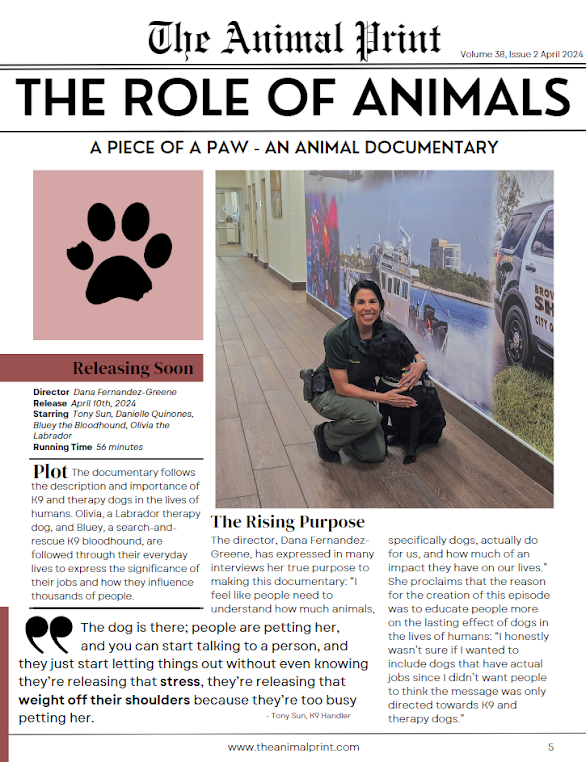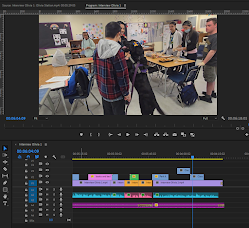Today I started with the print component of my piece: the 2-page magazine spread. I still need to finish the piece, however, I have started it and plan to finish it soon. So, I will document what I have done so far and what my plans are in terms of finishing it. Before I start, I'm going to say that I'm putting one picture at the beginning of this blog to show my progress and then I'm going to talk about the different aspects of it.
As I mentioned in my previous blog, I have already picked a template for both pages. I got them from 2 different sources on Canva, so the vibes and formatting of each one were originally, and still are a little different from one another. This made me have to make certain things match each other like the link and page numbers at the bottom, the indentation, the font, and the overall formatting of the pictures and text.
Like I just mentioned, that closely relates to the title I picked above, I made sure to edit and enter a new title and make up a link for the section on the bottom. I started with the fancy font section on the first page at the very top. I didn't really know what to put there until the title "The Animal Print" popped into my head. I actually am in love with that title and how the play on words doesn't only vaguely match my own piece, but also matches the medium this magazine spread/article would be released on. If I haven't mentioned it enough, I love play-on-words and phrases!
To connect this to the other page as well, I decided to copy the little bottom section from the first page, which includes the link and the page number, and place it onto my other magazine page as well. This not only would help the two pages be more cohesive, but it would include a nice little touch and have a fitting place for the page number without seeming like it was placed in the middle of nowhere. This is also where I decided to simply copy the title that I chose above and place it into the link to make a fake, but cute and matching link to the made-up magazine.
Going from the top down, the next section is the little bit of text to the title of the magazine on the first page. In case you can't see it, it reads, "Volume 38, Issue 2 April 2024." This subtext helps me relate it to the topic I want to connect my whole magazine spread to a critiquer that gives an early viewing of the documentary. This idea came from the many examples I saw and researched in my magazine spread blog posting when I first learned about my print component here.
Next, the title "The Role of Animals" would be the title of this specific magazine packet. This also allows me to further hone in on my actual topic and how it relates to my documentary piece. Using the topic relating to the role of animals in human lives not only closely relates to the topic of my therapy and K9 dog documentary, but it also helps viewers and the readers of the magazine to see more content on the same topic and learn more about that topic on a wider scale.
The subheading "A Piece of a Paw - An Animal Documentary" allows people to not only immediately see the title of my piece, but also get a little insight into the genre and vague format of the way I express my information through the piece.
The next thing I want to talk about is the quote. I mentioned this topic in the blog about the introduction to my print component as well. I don't know why but every time I read any type of magazine or newspaper, my eyes always dash straight towards any quotes on the page that are bolded or made bigger to bring attention. Obviously, that's the point of making the quotes stand out on the page, but since I've had that personal view of them, I decided to add them to my own magazine.
At first, I was going to add the quote "Most people say... animals are better than humans." This is actually the first line of my documentary; however, after a bit, I decided not to add that specific one since it was a little short for my taste and I wanted something longer and something that has a more lasting expression on someone. So, I decided to pick the quote that I did: "The dog is there; people are petting her, and you can start talking to a person, and they just start letting things out without even knowing they're releasing that stress, they're releasing that weight off their shoulders because they're too busy petting her." I feel like this quote really represents my piece in its entirety. It relates dogs with calming and how therapy dogs do their jobs by comforting and allowing people to destress.
Lastly, all I believe I have left is the actual text and the pictures (which I will probably use similar to my Instagram and the ones I use on here). I have a little bit of an outline of what I'm going to answer and use to write my text:
-A critique of my documentary from someone who saw it before it aired and was impressed by it.
-Talk about how it's influenced their lives and their perspectives on therapy and K9 dogs.
-How the documentary is for the greater good of the world.
-Dana






















